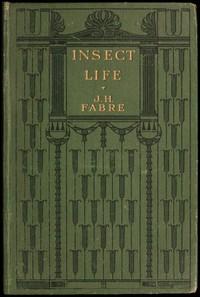|
|
Read this ebook for free! No credit card needed, absolutely nothing to pay.Words: 91349 in 12 pages
This is an ebook sharing website. You can read the uploaded ebooks for free here. No credit cards needed, nothing to pay. If you want to own a digital copy of the ebook, or want to read offline with your favorite ebook-reader, then you can choose to buy and download the ebook.

: Insect life: Souvenirs of a naturalist by Fabre Jean Henri Merrifield F Editor Parker M Prendergast Illustrator Roberts Margaret Translator - Insects Biology@FreeBooksThu 08 Jun, 2023 The Sacred Beetle Frontispiece Dung Beetles gathering Provender Facing page 6 Geotrupes stercorarius fighting for the Pellet 12 Cerceris bupresticida and its Prey; Bupresticis micans and Buprestis flavomaculata 46 Cerceris tuberculata dragging Weevil to its Burrow 54 Cerceris ferreri and its Prey, the Weevil; Rhynchites betulae on Birch Leaves, showing two leaves rolled up by the Weevil 58 Sphex flavipennis about to seize Grasshopper 120 Sphex occitanica taking a Sun Bath 136 The Sphex of Languedoc dragging to its Burrow an Ephippiger of the Vine 156 The Sphex of Languedoc and its enemy, the Praying Mantis 166 Ammophila hirsuta attacking a Grub 194 Ammophila sabulosa taking stone to cover its Burrow; A. argentata Mining 207 Ammophila hirsuta hunting for Caterpillars; Ammophila sabulosa on the Wing 208 Bembex rostrata taking Gadfly to its Nest; Bembex rostrata Mining 240 Mason Bees--Chalicodoma muraria on Old Nest 272 Mason Bees--Chalicodoma sicula and Nest 280 THE SACRED BEETLE This was how it came about. We were five or six, I the oldest and their professor, still more their comrade and friend; they, young fellows with warm hearts and lively imaginations, overflowing with that youthful vitality which makes one so open to impressions and so eager for knowledge. Talking of one thing and another we followed a path bordered with elder and hawthorn, where already the Rose Beetle was revelling in the overwhelming scent of the clustering blossoms. We were going to see if the Sacred Scarabaeus had yet appeared on the sandy plateau of Les Angles, rolling the ball of dung which ancient Egypt looked on as emblematic of the world; we wanted to discover whether the running stream at the bottom of the hill might not hide young newts under the net of water weeds--newts whose branchiae look like tiny sprays of coral; to see if that elegant little fish of the rivulet, the stickleback, had donned his wedding cravat of azure and purple; if the new-come swallows were dipping on pointed wings over the meadows chasing the midges which scatter their eggs in their airy dance; to see if the Eyed Lizard was sunning his blue-spotted body at the mouth of a hole made in the sandstone; or if the flocks of Laughing Gulls, come up from the sea after the legions of fish which ascend the Rh?ne to spawn, were hovering over the river, and now and again uttering their cry like the laugh of a maniac. But enough; suffice it to say that, like simple folk who find much pleasure in living with the brute creation, we were intending to spend a morning in enjoying the ineffable awakening of life in springtime. We were not disappointed. The stickleback was in full dress, his scales would have made silver look dim; his throat was of the brightest vermilion. On the approach of a great horse-leech with no good intentions, up rose the spines on back and side as if moved by a spring. Thus bravely encountered, the bandit beat an ignominious retreat down among the water-plants. The dull race of molluscs, Planorbinae, and water-snails were sucking in air on the surface of the water, and the great Water Beetle, with its hideous larva, went by wringing the neck now of one, now of another, without the stupid band seeming to notice it. But let us leave the waters of the plain and climb the steep cliff dividing us from the tableland where sheep are feeding and horses are being exercised for the approaching races, one and all bestowing largesse on the rejoicing dung beetles. For here at work are the scavenger beetles to whom is entrusted the high office of clearing the ground of impurities. It is impossible to admire sufficiently the variety of tools with which they are furnished, both to stir the dung with, to divide and shape it, and to hollow the deep retreats into which they shut themselves with their booty. These tools form a kind of technological museum, where there is a specimen of every kind of digging instrument. Some might be copied from those devised by human industry, others are of an original type, and might serve as models for new tools for man. Copris hispanica wears a strong horn on its head, forked and bent back, like the long spike of a pickaxe. To a similar horn C. lunaris adds two strong points, shaped liked a ploughshare, projecting from the thorax, and between them a sharp-edged protuberance, serving as a wide rake. Bubas bubalus and B. bison, both exclusively Mediterranean species, have foreheads armed with two stout, diverging horns, between which projects a horizontal share from the corslet. Geotrupes typhaeus carries three points on the front of its thorax, parallel and standing straight out, the middle one shorter than the others. Onthophagus taurus owns as implements two long curving appendages like the horns of a bull, while the furcate Onthophagus has a two-pronged fork on its flat head. Even those least well off have on one part or other hard tubercules--tools blunt indeed, but which the patient insect knows very well how to utilise. All are furnished with a shovel, i.e. a large, flat, sharp-edged head; all use a rake--in other words, they collect materials with their toothed front legs. As compensation for their unpleasant work, more than one gives out a strong scent of musk, and its ventral parts gleam like polished metal. Geotrupes hypocrita has the under part of its body bright with metallic lights of copper and gold, and G. stercorarius with amethystine violet. But the usual colour is black. It is in tropical regions that we find dung beetles in gorgeous array--absolutely living jewels. Under camel droppings in Upper Egypt is found a beetle rivalling the dazzling green of an emerald; Guiana, Brazil, Senegal, can show Copridae of a metallic red, rich as the red of copper, bright as that of a ruby. If such a jewelled race be wanting to our country, still its dung beetles are not less remarkable for their habits. What eagerness is displayed around a dropping! Never did adventurers from the four corners of the world show such eagerness in working a Californian claim! Before the sun grows too hot there they are by hundreds, large and small, pell-mell, of every kind and form and shape, hastening to secure a slice of the cake! Some work in the open air and rake the surface, some open galleries in the thickest part, seeking choice morsels, others toil in the under part and bury their treasure as soon as possible in the adjacent ground, and the smallest crumble some scrap fallen from the excavations of their strong fellow-workers. Some again--newcomers, and doubtless the hungriest--eat then and there, but the aim of the greater number is to lay up a store which will allow them to pass long days of plenty down in some sure retreat. A fresh dropping is not to be found just when wanted in a plain where no thyme grows; such a gift is indeed a piece of good fortune, and only comes to the lucky. So when found, the wealth is prudently stored. The smell has carried the good news a couple of miles round, and all have rushed to gather up provender. Some laggards are still coming in on the wing or on foot. What is the one now trotting towards the heap, fearing to arrive too late? His long legs work with a brusque, awkward action, as if moved by some machine inside him; his little red antennae spread their fans--sure sign of anxious greediness. He is coming, has arrived, not without upsetting some of the guests. It is the Sacred Beetle, all in black, the largest and most celebrated of our dung beetles. Here he is at table, beside his fellow-guests, who are giving last touches to their balls with the flat of their large front legs, or enriching them with a last layer before retiring to enjoy the fruit of their labours in peace. Let us follow this famous ball in each stage of construction. The edge of the beetle's head is large and flat, and armed with six angular teeth arranged in a semicircle. It is the tool for digging and dividing, the rake to lift or reject such vegetable fibres as are not nutritious, to seek out what is best and rake it together. A choice is thus made, for these keen connoisseurs like one thing better than another--a somewhat careless choice, indeed, if the beetle alone be concerned, but one which is rigorously scrupulous if the maternal ball be in question, with its central hollow where the egg will hatch. Then every scrap of fibre is rejected, and only the quintessence of the stercorous matter is used to build the inner layer of the cell. Then, as soon as it is hatched, the young larva finds in the walls of its dwelling a dainty food which strengthens digestion and enables it later to attack the coarse outer layers. For its own needs the beetle is less fastidious, contenting itself with a general selection. The toothed head hollows and seeks, rejects and gathers, somewhat at haphazard. The forelegs aid mightily. They are flattened, bent into the arc of a circle, are furnished with strong nerves and armed with five stout teeth. If an effort has to be made, an obstacle overthrown, a path forced through the thickest part of the heap, the dung beetle elbows its way; in other words, throws its toothed legs right and left, and clears a half circle with a vigorous sweep of its rake. Room being made, these same feet have a new task; they collect bundles of the material raked up by the head, and pass it under the insect to the four hind-feet. These are planned for the turner's trade. The legs, especially the last pair, are long and slender, slightly bent in an arc, and ending in a very sharp spur or talon. A glance shows that they form a spherical compass, capable of holding a globe in the bent legs to verify and correct its shape. In fact, their mission is to shape the ball. Bundle after bundle the material accumulates under the insect, held between the four legs which by a slight pressure lend it their own curve and something of shape. Then from time to time the rough hewn ball is set in motion between the legs of the double spherical compass, turned underneath the beetle, and rolled into a perfect sphere. Should the outer layer fail in plasticity and threaten to scale off, or if some part be too fibrous, and refuse to be shaped by rotation, the faulty part is retouched by the forefeet; little taps of their broad surface give consistency to the new layer and imbed the recalcitrant fibre in the general mass. When the sun shines and work is urgent, one is amazed by the feverish activity with which the turner labours. Work goes on fast; first there was a pellet, now it is as large as a nut, by and by it will be of the size of an apple. I have seen some greedy beetles make up a ball as large as an apple. Assuredly there is food in the larder for some days to come! Provender being gathered, the next thing is to retire from the m?l?e, and carry it to a fitting place. Now we see some of the most characteristic habits of the Scarabaeus. He sets out at once, embracing the ball with the long hind legs, whose talons, planted in the mass, serve as pivots--leans on the intermediary legs as pivots, and using as levers the flat of the toothed forefeet, which press the ground alternately, journeys backward with his load, the body bent, the head low, and the hinder part upraised. The hind feet, which are the chief organs in the mechanism, move continually, going and coming and changing the place where the talons are stuck in, to alter the axis of rotation, to keep the load balanced and advance by an alternate push right and left. Thus the ball comes in contact with the ground in every part of it, which gives it a perfect shape and lends consistency to the outer layer by a uniform pressure. Courage! it moves, it rolls, and the journey's end will be reached, though not without trouble. Here is a first difficulty. The beetle has to cross a slope, and the heavy ball would naturally follow the incline, but for reasons best known to itself, the insect prefers to cross this natural slope--an audacious plan, which one false step or a grain of sand to upset the balance will defeat. The false step is made, the ball rolls to the bottom of the valley, and the insect, upset by the impetus of its load, staggers, gets again on its legs, and hastens to harness itself afresh. The mechanism works capitally. But look out, scatterbrain! follow the hollow of the valley, it will spare labour and misadventure. The road is good and quite level, and your ball will roll along with no exertion. Not a bit of it. The insect has made up its mind to remount the slope already so fatal to it. Perhaps it suits it to return to the heights. Against that I have nothing to say, the Scarabaeus knows better than I do whether it be advisable to dwell in lofty regions. At all events, take this path which will lead you up by a gentle incline. Not at all. If there be near at hand some very stiff slope impossible to climb, then that slope this wrong-headed insect prefers. Then begins the labour of Sisyphus. With endless precautions the monstrous load is painfully hoisted, step by step to a certain height, the beetle always going tail first. One asks one's self by what miracle of statics such a mass can be kept on the slope. Ah! a clumsy movement brings all this toil to naught. Down goes the ball, dragging the beetle with it. The escalade is repeated, soon followed by a fresh fall. The attempt is renewed, and better managed at the difficult points; a nasty grass-root, which occasioned the previous tumbles, is prudently turned; we have almost got to the top. But gently! gently! the ascent is perilous, and a mere nothing may ruin all. A leg slips on a bit of smooth gravel, and ball and scavenger roll down together. The beetle begins all over again, with tireless obstinacy. Ten times, twenty times, will it attempt that further ascent, until persistency vanquishes all obstacles, or until, better advised, it takes the level road. Free books android app tbrJar TBR JAR Read Free books online gutenberg More posts by @FreeBooks
: The passing of the great race; or The racial basis of European history by Grant Madison Osborn Henry Fairfield Author Of Introduction Etc - Ethnology Europe@FreeBooksThu 08 Jun, 2023

: Dark Dawn by Kuttner Henry - Science fiction; Short stories; Blind Fiction; Nuclear weapons Testing Fiction@FreeBooksThu 08 Jun, 2023
|
Terms of Use Stock Market News! © gutenberg.org.in2025 All Rights reserved.






